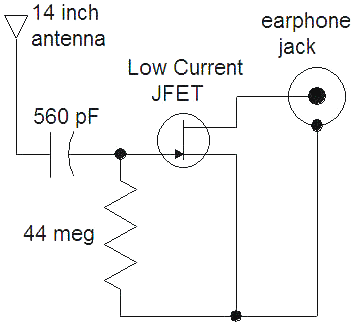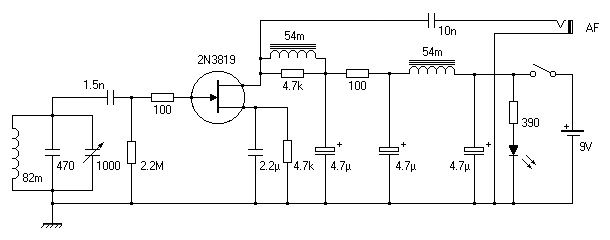

This is why we see tweek tails at this base frequency range. All wave guides have a cut-off frequency and the Earth-ionosphere wave guide’s cut-off frequency is around 1.7KHz. Dispersion is associated with the cut-off frequency of a wave guide. The lower frequencies only lag by a few hundredths of a second, but this is enough to change how a spheric sounds at great distances. Dispersion is the process of higher frequencies arriving at the receiver slightly faster than lower frequencies. Tweeks are spherics that have traveled for many thousands of kilometers through the Earth-ionosphere wave guide, and because of this they undergo dispersion. Here’s an example of a tweek with a very long tail captured with my setup. It is this “tail” that gives tweeks their unique sound. On a spectrogram tweeks generate a small tail at around 2KHz and it’s harmonics.

They can easily be distinguished from normal spherics just by their ringing sound alone. Tweeks get their name from the distinctive “tweek” sound they produce. These types of spherics are called tweeks. This allows VLF signals to travel considerably further at night.ĭuring the night hours, spherics from much further than 2000 or 3000 kilometers can be heard! As a matter of fact during night hours it is possible to hear spherics from clear across the planet. At night though it’s presumably the much higher E and F layers that are responsible for the sky wave component of a VLF signal. These spherics reach the receiver via the wave guide created by the D layer and the Earth’s surface. During the daylight hours spherics can travel upwards of 2000 to 3000 kilometers from the source of the lightning strike. This phenomena can easily be seen on a SID receiver plot as a sharp rise in the received signal strength of a monitored VLF transmitter at dusk and the subsequent signal drop at dawn. This is due to the lack of ionizing radiation from the Sun during the night hours. At dusk the D layer (lowest layer) of the ionosphere fades away leaving the higher E and F layer only. During dusk, dawn and the intervening night hours the ionosphere goes through a transformation that has a profound effect on spheric activity. Thankfully, there is more to natural radio than just spherics. Yes I agree, after a short while spherics can get very boring. Ok, you might be asking yourself what’s the big deal about popping sounds from lightning in the VLF band anyway. That is if you don’t want to build your own receiver. I recommend this receiver for anyone interested in getting into this hobby. The VLF-3 kit which they provide is of very good quality and easy enough for just about anyone to build in a few quiet nights in the radio shack. The Inspire Project is a NASA sponsored (among others) project involved with interactive NASA space physics ionosphere radio experiments. Another option is the VLF-3 from the Inspire Project. I’m currently using a homemade receiver for this project which I detail below. As a matter of fact the Schumann resonance receiver which I use, found here, can easily be modified to receive the entire VLF band. Over the years I have built a number of VLF receivers of the E-field and loop antenna type. I have been interested in natural radio for a good ten years now. So it shouldn’t surprise anyone that another name for this hobby is “natural radio”. These types of wide band signals are characteristic of natural EMF activity from Earth as well as our solar system and beyond. This is because a lightning strike is not a narrow band event as is say a military VLF transmitter like NAA in Cutler Maine at 24KHz. Spherics show up as wide band bursts when plotted on a spectrogram. These are the most common sounds heard on the VLF band and can be heard 24 hours a day. The snap, crackle, and pop sounds from lightning activity which one can hear on a VLF receiver, or AM and short wave radio for that matter are called atmospherics or spherics for short.


 0 kommentar(er)
0 kommentar(er)
